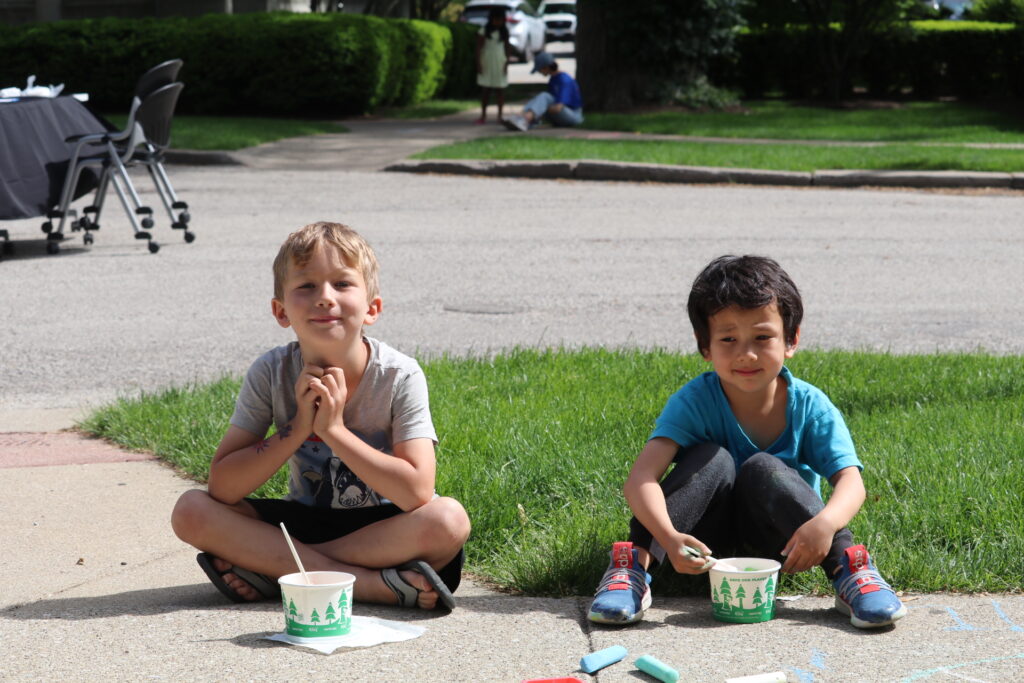Since antiquity art has been used as a medium to express ourselves and our experiences. When art is blended with theology it becomes a powerful tool for exploring and expressing ideas about the divine and about moral and ethical values in tangible ways. Art and theology both aim to express human experiences and our connection and understanding of the divine. While traditional theological discourse uses words, doctrines, and teachings, art uses visuals, music, and performances for understanding and expressing these concepts. Art makes it possible for an embodied experience and engagement with theology in creative ways. When combined, they help us understand deeper truths about life and our connection to the divine, making the sacred more tangible and accessible. This connection between art and ethics was clear at the “Chalk it up for a Better World” event where kids from Evanston area used sidewalk art to express what ethics and theology meant for them.
In my own work, I have found that art serves as a powerful medium to explore, articulate, and reimagine, theological concepts in tangible ways that cannot always be expressed in words. On May 19, the Stead Center organized a unique event that brought together children and youth to create art on the sidewalks around Garrett’s campus. This event, “Chalk it up for a Better World,” aimed to encourage young participants to reflect on their understanding of ethics and values through the medium of sidewalk chalk art.

The event was more than just an art project; it was an exercise in community-building and ethical education. Children drew their visions of a better world, from grand ideas of justice and equity to simple yet profound concepts such as friendship, peace, and home. Among the artwork, one child drew a picture of friends holding hands, symbolizing unity, and mutual support. Another created an image of a peaceful morning by the lake with trees, lake, birds, and the sun, reflecting calmness and harmony with nature. These are just a few examples; there were many more imaginative and whimsical drawings, like a grape-flavored sun, that brought joy and creativity into the mix. These pieces of art, though it may appear simple, embody deep theological and ethical themes. Friendship and peace are central to many religious teachings, emphasizing the importance of loving and respecting one another. The concept of peace resonates across cultures, offering aspiration for harmony and tranquility among all people. Even the playful elements, like the grape-flavored sun, remind us of the joy even in the mundane.
Working with groups, especially young people, to help them learn about ethics through art was an enriching experience. It involves guiding them not just in artistic techniques but also in ethical reflection. One of the most rewarding aspects of this experience was seeing how the children’s creativity flourished when they were given the freedom to express their ideas. The sidewalk art event provided a space where their voices could be heard and their visions seen, validating their perspectives, and encouraging them to think deeply about ethical issues.
The event emphasizes the importance of merging art and theology. It also shows how art provides a creative and embodied experience to explore theological and ethical concepts that is personal, relatable, and accessible especially for children and young adults. Additionally, events like this highlights the role of the community in theological and ethical formation. This communal aspect is crucial for building a shared vision of a just and equitable society.
Art and theology combined offer powerful means to explore and communicate ethical and theological ideas. The “Chalk it up for a Better World” event demonstrated how art can be used to engage young people in ethical reflection, fostering a deeper understanding of justice, equity, and inclusion. As we continue to seek creative ways to teach and learn about ethics, the integration of art and theology will undoubtedly play a crucial role in shaping our collective vision of a just world.